Build an Effective Music Theory Practice Schedule
Category: Music Theory
Master Music Theory with the Perfect Practice Routine
If you're a beginner musician or an enthusiastic learner trying to break down the complexities of music theory, you're likely overwhelmed by where to start or how to organize your study time effectively. Maybe you’ve found endless tutorials on guitar chords or piano scales but struggle to weave theory into your daily practice. This post is for you — it’s designed to guide you in creating a structured, manageable, and results-driven practice schedule that makes learning music theory feel less intimidating and more rewarding.
You probably arrived here searching for a way to get more disciplined in your practice or to stop feeling stuck and scattered in your approach. Unlike generic advice, this blog focuses on beginner-friendly strategies tailored to both guitar and piano players, blending theoretical concepts with practical exercises. Whether you have 15 minutes or an hour to devote each day, building a consistent schedule is key to mastering music theory fundamentals and translating that knowledge into real playing skills. Read on to discover how to design your practice sessions to maximize growth, keep motivation high, and build confidence on your instrument.
- Master Music Theory with the Perfect Practice Routine
- Understanding Your Goals: Identifying Specific Music Theory Concepts for Guitar and Piano
- Assessing Your Current Skill Level: How to Evaluate Your Starting Point to Tailor Your Practice Effectively
- Allocating Time Wisely: Tips for Dividing Daily or Weekly Practice Between Theory and Instrument Application
- Breaking Down Music Theory Topics: Structuring Practice Segments for Scales, Chords, Intervals, Rhythm, and Ear Training
- Integrating Instrument Practice: Applying Theory Lessons Directly to Piano and Guitar Exercises for Practical Understanding
- Using Resources Effectively: Recommendations for Beginner-Friendly Books, Apps, and Online Tutorials Focused on Theory and Instrument
- Tracking Progress and Adjusting the Schedule: Setting Milestones, Using Practice Journals, and Adapting Your Plan as You Improve
- Staying Consistent and Motivated: Strategies to Maintain Your Music Theory Practice Routine
- Sample Weekly Practice Plan: Tailored Schedules for Different Time Commitments and Skill Levels
- Common Challenges and How to Overcome Them: Addressing Boredom, Confusion, and Lack of Immediate Progress
Understanding Your Goals: Identifying Specific Music Theory Concepts for Guitar and Piano
Before you dive into building your practice schedule, it’s essential to clarify which music theory topics you want to master—especially as they relate to the guitar and piano. Setting clear, focused goals helps you target your efforts efficiently and prevents the common frustration of trying to learn too many concepts at once. Whether your aim is to improve your chord vocabulary, understand scales better, or analyze song structures, being specific about your goals will guide your learning path and practice priorities.
Start by asking yourself what practical skills you want to develop with theory. For example, guitarists often benefit from mastering chord construction, barre chords, and modal scales, while pianists might focus on reading sheet music, voice leading, and chord inversions. Here are some targeted topics to consider:
- Basic notation and rhythm - Crucial for both guitar and piano to read and interpret music accurately.
- Intervals and scales - Learning major, minor, pentatonic, and modes will improve improvisation and soloing skills.
- Chord theory - Understanding triads, seventh chords, and extended chords enhances harmonic comprehension.
- Key signatures and circle of fifths - Helps in transposing music and understanding relationships between keys.
- Progressions and cadences - Essential for composing, analyzing songs, and accompaniment.
By pinpointing which of these areas align with your current skill level and musical interests, you can tailor your practice sessions around relevant theory exercises and instrument application. This focused approach not only builds confidence but ensures that every minute spent practicing moves you closer to tangible results on the guitar or piano.
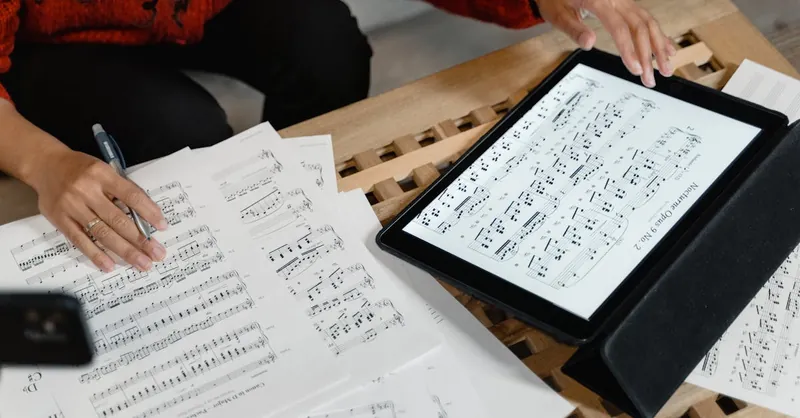
Image courtesy of Tima Miroshnichenko
Assessing Your Current Skill Level: How to Evaluate Your Starting Point to Tailor Your Practice Effectively
Before building an effective music theory practice schedule, it’s vital to assess your current skill level honestly. Knowing exactly where you stand — whether you’re a complete beginner or have some familiarity with theory concepts — enables you to customize your learning plan so it fits your needs precisely. This evaluation prevents wasted time on material that’s too easy or too advanced, helping you maintain motivation and steady progress on both guitar and piano.
Start by conducting a self-assessment that covers fundamental areas such as note reading, rhythm recognition, interval identification, and basic chord and scale knowledge. For example, can you confidently name the notes on the treble and bass clefs? Are you comfortable identifying major and minor triads by ear or sight? Can you play or recognize simple scales and chord progressions on your instrument? Answering these questions helps pinpoint strengths and reveal gaps.
Here’s a quick checklist to evaluate your music theory foundation:
- Reading musical notation: Can you read sheet music fluently on guitar tablature and piano staff?
- Understanding rhythm patterns: Are you able to count and clap different time signatures accurately?
- Recognizing intervals and scales: Can you identify intervals like perfect fifths or minor thirds, and distinguish between major, minor, and pentatonic scales?
- Chord knowledge: Do you understand how triads are built and can you construct basic chords on your instrument?
- Applying theory to playing: Can you translate theory concepts to real-time playing, like improvising a solo or accompanying with chord progressions?
If some areas feel uncertain, you might want to begin with focused exercises addressing those fundamentals to build a strong theoretical foundation. Conversely, if you find particular topics easy, challenge yourself with more advanced exercises like extended chords, modal harmony, or transposition drills. Tailoring your practice based on this honest self-evaluation makes your study sessions more productive, engaging, and aligned with your musical goals on both guitar and piano.
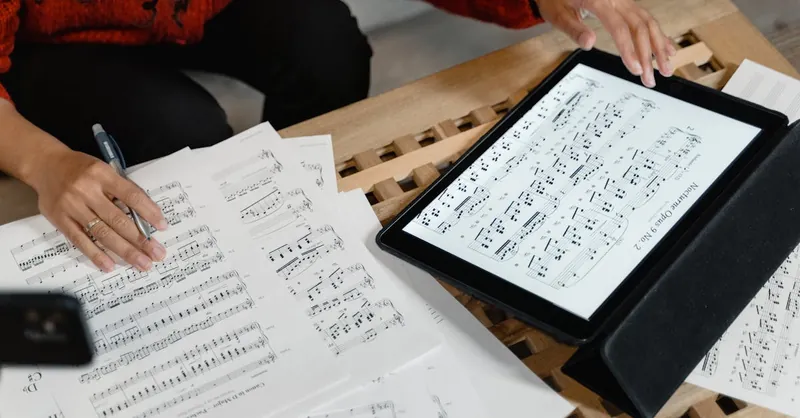
Image courtesy of Tima Miroshnichenko
Allocating Time Wisely: Tips for Dividing Daily or Weekly Practice Between Theory and Instrument Application
Creating an effective practice schedule means striking the right balance between music theory study and practical application on your guitar or piano. Spending time solely on theory without playing can feel abstract and disconnected, while only practicing your instrument without understanding the underlying concepts may limit your musical growth. To maximize progress, allocate your practice time strategically to reinforce both cognitive understanding and hands-on skill development.
How to Divide Your Practice Time
- Start with your goals and available time: If you have 30 minutes, consider splitting your session into two focused segments — about 15 minutes dedicated to learning or revising theory concepts and 15 minutes applying that theory on your instrument. For longer sessions, such as an hour or more, you can extend each portion or include brief breaks to maintain focus.
- Integrate theory into playing exercises: For example, after studying a new scale or chord pattern, spend time practicing it on your guitar or piano, experimenting with different fingerings, and playing it in various keys. This hands-on application deepens understanding and aids retention.
- Alternate intensity based on your schedule: Some days, focus more on theory to tackle complex topics like chord progressions or rhythm notation. Other days, emphasize playing improvisations, sight-reading, or repertoire that reinforces what you've learned. This variety keeps practice engaging and holistic.
- Use weekly planning: Dedicate certain days to heavier theory study and others predominantly to practical work. For instance, Monday, Wednesday, and Friday could focus on theory concepts and exercises, while Tuesday, Thursday, and weekend sessions center around playing application and creative exploration.
Practical Tips for Effective Time Allocation
- Set a timer: Use a timer or music practice app to define clear blocks of time for different activities, avoiding the urge to linger too long on one aspect.
- Keep sessions manageable: Consistent daily practice, even if it’s just 15-20 minutes, often yields better results than sporadic, lengthy sessions.
- Track your progress: Maintain a simple journal or digital log to record what theory topics you covered and how you applied them on your instrument. Reflecting weekly helps you adjust your time allocation as your skills evolve.
By consciously dividing your practice time between theory study and instrumental application, you foster a more integrated learning experience. This balanced approach guarantees that music theory doesn’t remain an abstract concept but becomes a practical tool that enhances your guitar and piano playing, boosting both your confidence and creativity.
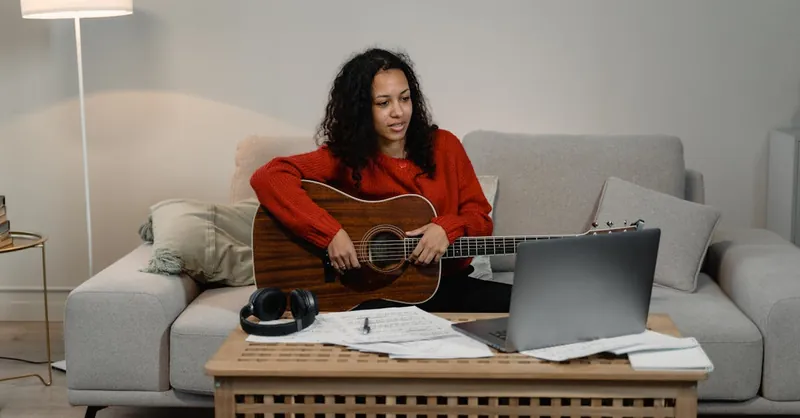
Image courtesy of Tima Miroshnichenko
Breaking Down Music Theory Topics: Structuring Practice Segments for Scales, Chords, Intervals, Rhythm, and Ear Training
To build an effective and balanced music theory practice schedule, it’s crucial to break down key theory topics into focused segments that you can systematically explore and apply on guitar and piano. Dividing your study time among areas like scales, chords, intervals, rhythm, and ear training ensures comprehensive development and prevents any single aspect from being neglected. Organizing your sessions this way not only keeps practice varied and engaging but also deepens your understanding by linking theory directly to your playing.
Key Music Theory Topics to Structure Your Practice
- Scales:
- Practice major, minor, pentatonic, and modal scales relevant to your instrument.
- Focus on fingering patterns, scale degrees, and how scales relate to keys and modes.
-
Use scales to improvise simple melodies or solos, reinforcing both technical skill and theoretical insight.
-
Chords:
- Study chord construction methods, including triads, seventh chords, and extended chords.
- Learn chord voicings and inversions on both guitar and piano to improve harmonic fluency.
-
Practice common chord progressions (I-IV-V, ii-V-I, etc.) and experiment with substitutions to enhance accompaniment skills.
-
Intervals:
- Train to recognize and identify intervals by sight and ear, essential for melody and harmony comprehension.
-
Practice interval exercises on your instrument, such as playing and singing ascending and descending intervals.
-
Rhythm:
- Work on counting and clap exercises in various time signatures, focusing on note durations, rests, and syncopation.
-
Apply rhythmic patterns while playing chords or melodies, integrating timing precision with theoretical knowledge.
-
Ear Training:
- Develop your ability to identify intervals, chord qualities, and rhythms by ear, improving musical intuition.
- Use apps or online resources for guided ear training exercises, starting with simple recognition and progressing to dictation.
Tips for Integrating These Segments into Your Practice Routine
- Divide your session into clear blocks: For example, a 30-minute practice might include 7 minutes of scale exercises, 7 minutes of chord work, 5 minutes on intervals, 5 minutes of rhythm practice, and 6 minutes of ear training.
- Rotate focus areas daily: While maintaining all topics regularly, assign slightly longer sessions to one area each day based on your goals or challenges.
- Link theory to instrument application: After studying a theory topic, immediately apply it through technical exercises or musical examples on guitar or piano to reinforce understanding and retention.
By structuring your practice schedule around these foundational music theory topics—balanced between cognitive learning and practical instrument work—you’ll build a solid, interconnected knowledge base. This methodical approach accelerates your progress, boosts your confidence, and bridges the gap between theory and real-world musicianship on both guitar and piano.
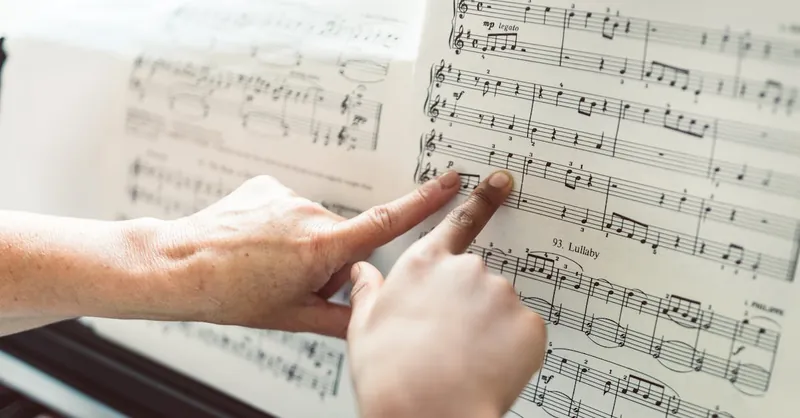
Image courtesy of RDNE Stock project
Integrating Instrument Practice: Applying Theory Lessons Directly to Piano and Guitar Exercises for Practical Understanding
To truly internalize music theory concepts, it’s essential to bridge the gap between theoretical knowledge and your instrument performance. Integrating theory lessons directly into your piano and guitar practice not only reinforces your understanding but also makes learning more engaging and immediately rewarding. Instead of treating music theory as a separate abstract subject, apply each new concept with hands-on exercises that demonstrate how it functions in real musical contexts.
Practical Application Strategies for Guitar and Piano
-
Translate Theory into Technical Exercises:
After learning a new scale, mode, or chord type, practice playing it on your instrument in various keys and positions. For guitarists, this could mean drilling scale patterns across the fretboard or experimenting with chord voicings and inversions. Pianists might focus on playing scale passages with proper fingerings or voice leading chord progressions smoothly across octaves. -
Integrate Theory with Repertoire:
Apply theory knowledge by analyzing and playing simple songs or progressions that feature the concepts you're studying. Identify the chord functions, scales used for melodies or solos, and rhythmic patterns, then replicate or improvise around these elements on guitar or piano. This deepens your contextual understanding and strengthens your ear-muscle connection. -
Use Improvisation as a Learning Tool:
Once comfortable with scales and chord tones, practice improvising short phrases or melodies over backing tracks or metronome clicks. This active use of theory helps you internalize interval relationships, scale degrees, and harmonic tensions on your instrument, boosting both creativity and technical facility. -
Incorporate Ear Training with Instrument Practice:
Combine listening exercises with playing by identifying intervals, chord qualities, or rhythms by ear, then recreating them on your piano or guitar. This integrated approach heightens your musical intuition and reinforces theory knowledge in a natural, practical way.
By consistently weaving music theory principles into your instrument practice, you transform abstract lessons into tangible skills. This dynamic method accelerates learning, improves sight-reading, fretboard or keyboard navigation, and ultimately empowers you to play with greater confidence and musicality on both guitar and piano.
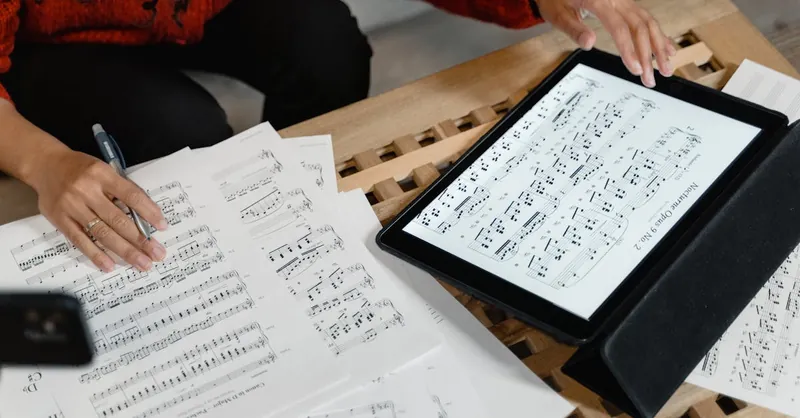
Image courtesy of Tima Miroshnichenko
Using Resources Effectively: Recommendations for Beginner-Friendly Books, Apps, and Online Tutorials Focused on Theory and Instrument
To build a solid and efficient music theory practice schedule that seamlessly integrates guitar and piano learning, leveraging the right resources is crucial. Beginner-friendly books, apps, and online tutorials tailored to both theory fundamentals and practical instrument application can provide structured guidance, interactive exercises, and real-time feedback—key elements for accelerating your progress and maintaining motivation.
Recommended Books for Music Theory Beginners
-
“Music Theory for Dummies” by Michael Pilhofer and Holly Day
This approachable guide covers essential theory concepts in clear language, including notation, scales, chords, and rhythm. It offers practical examples that guitarists and pianists can easily relate to, making it a perfect starting point. -
“Hal Leonard Guitar Method” and “Alfred’s Basic Adult Piano Course”
While these are technically instrument method books, both include accessible theory sections integrated with playing exercises, helping beginners apply theory directly to guitar or piano. -
“Edly’s Music Theory for Practical People” by Ed Roseman
Known for its down-to-earth explanations, this book breaks music theory down into manageable lessons that connect theory to real playing situations on various instruments.
Best Apps for Interactive Music Theory and Instrument Practice
- Tenuto: Excellent for ear training, interval recognition, and notation quizzes. It offers customizable drills that build your theoretical skills alongside sight-reading practice.
- Yousician: A gamified app designed for both guitar and piano learners. Yousician includes lessons that blend music theory with playing songs, making learning fun as you progress.
- Simply Piano by JoyTunes: Focused on piano beginners, this app guides you through theory fundamentals while you play along, with instant feedback to refine your skills.
- GuitarTuna: Apart from its tuning capabilities, it includes chord libraries and beginner-friendly theory games to solidify your grasp of guitar basics.
Online Tutorials and Platforms
- Musictheory.net: Offers free, concise lessons on theory topics like scales, chords, and rhythm, complemented by interactive exercises. It's ideal for beginners seeking clear, bite-sized theory lessons.
- JustinGuitar: A comprehensive platform with free guitar tutorials emphasizing theory and practice in tandem. It’s great for building chord vocabulary and understanding songwriting fundamentals.
- PianoLessons.com: Provides piano tutorials that incorporate music theory concepts with hands-on keyboard exercises, suitable for learners who want a structured video course.
- YouTube Channels like “Rick Beato” and “Michael New”: These creators break down complex theory ideas into beginner-friendly videos specifically tailored for guitarists and pianists, often showing practical applications.
Maximizing Resource Use in Your Practice Schedule
- Combine theory study and instrument exercises: Use books or tutorials to learn a new concept, then immediately apply it on your guitar or piano.
- Schedule short, focused sessions with apps: Incorporate daily 5-10 minute app drills to boost ear training and recognition skills alongside your regular practice.
- Leverage free online resources for theory reinforcement: Bookmark tutorials and lesson websites to supplement your practice and clarify challenging topics.
By effectively utilizing targeted books, apps, and tutorials designed for beginners, you create a rich learning environment where music theory is accessible, engaging, and directly connected to your progress on guitar and piano. This strategic use of resources ensures your practice sessions remain dynamic, goal-oriented, and rewarding—accelerating your journey toward music theory mastery and confident musicianship.
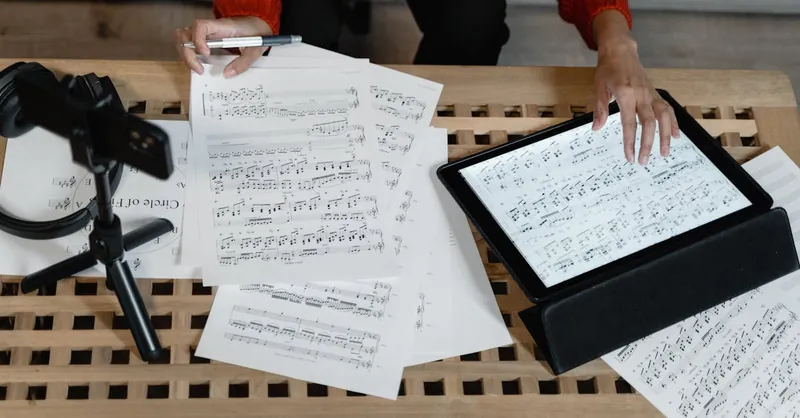
Image courtesy of Tima Miroshnichenko
Tracking Progress and Adjusting the Schedule: Setting Milestones, Using Practice Journals, and Adapting Your Plan as You Improve
An essential part of building an effective music theory practice schedule is consistently tracking your progress and making adjustments based on your evolving skills and goals. Without monitoring how far you’ve come, it’s easy to lose motivation or spend too much time on material that no longer challenges you. By setting clear milestones, maintaining a practice journal, and regularly reviewing your plan, you ensure your study remains purposeful, scalable, and aligned with your growth on both guitar and piano.
Setting Clear Milestones
Breaking down your long-term music theory goals into achievable milestones gives your practice direction and measurable checkpoints. For example, you might set goals like:
- Mastering all major and minor scales in two keys within two weeks.
- Being able to identify intervals by ear with 80% accuracy over one month.
- Playing and analyzing basic chord progressions like I-IV-V on both guitar and piano fluently within three weeks.
Milestones create a sense of accomplishment and encourage incremental progress rather than overwhelming yourself with large, vague objectives. When you hit a milestone, celebrate the success before moving to more advanced challenges.
Using a Practice Journal for Reflection and Accountability
Recording your daily or weekly practice sessions in a journal—whether digital or physical—helps you keep track of:
- Which theory concepts you studied and practiced on guitar or piano.
- Difficulties or breakthroughs encountered during exercises.
- New repertoire or improvisation ideas inspired by your learning.
- Time spent on each topic to evaluate the balance of your schedule.
This reflective habit not only builds accountability but also reveals patterns in your learning, highlighting strengths to build on and weaknesses to address. Over time, reviewing your journal entries will show undeniable evidence of growth, motivating you to keep pushing forward.
Adapting Your Practice Schedule Based on Progress
As you develop stronger music theory skills and become more comfortable applying them on your instrument, it’s important to adapt your schedule to match your current level and evolving interests. Don’t hesitate to:
- Increase the complexity of theory topics, such as moving from basic triads to extended chords or more advanced rhythmic patterns.
- Rebalance your time allocation if you notice that certain areas (like ear training or improvisation) need more focus.
- Incorporate more creative exercises or apply theory in songwriting and composition as your confidence grows.
Flexibility in your practice routine keeps it fresh and aligned with your musical journey, preventing plateaus and burnout. Regularly revisiting your goals, assessing progress, and fine-tuning your schedule ensures a consistent upward trajectory in both understanding and performance on the guitar and piano.
By setting milestones, tracking your practice diligently, and adapting your schedule thoughtfully, you transform your music theory learning into a dynamic, responsive process that fosters sustained improvement and musical mastery.

Image courtesy of Photo By: Kaboompics.com
Staying Consistent and Motivated: Strategies to Maintain Your Music Theory Practice Routine
Maintaining a consistent practice routine in music theory is often the biggest challenge for beginner guitar and piano players. To build lasting progress, it’s essential to develop strategies that keep you motivated, help you overcome plateaus, and encourage you to celebrate small wins along the way. Without consistent effort, even the best practice schedule won’t yield results, so nurturing motivation is just as important as the structure of your sessions.
Key Strategies to Stay Consistent and Motivated
-
Set Realistic, Manageable Daily Goals:
Aim for achievable practice targets, such as mastering one chord inversion or identifying intervals for 10 minutes per session. Small, focused goals prevent burnout and make it easier to commit daily—even on busy days. -
Use Variety to Combat Plateaus:
When your progress feels slow or repetitive, switch up your practice activities. Alternate between analyzing chord progressions, ear training, rhythm exercises, and improvisation. This variation keeps your brain engaged and accelerates learning on guitar and piano alike. -
Celebrate Small Wins Regularly:
Acknowledge milestones like playing your first barre chord smoothly or accurately recognizing all major key signatures. Tracking these victories fuels your motivation and builds confidence, reminding you that steady effort brings tangible results. -
Create a Supportive Practice Environment:
Designate a distraction-free space for your sessions, and consider practicing with a friend or joining online communities to share progress and challenges. Social encouragement can inspire consistency and introduce accountability. -
Incorporate Rewards and Positive Reinforcement:
Reward yourself after completing practice sessions or hitting milestones—whether that’s a break, a favorite snack, or listening to a song you love. Positive reinforcement helps associate practice with enjoyable experiences, making it easier to maintain a routine.
By embedding these motivation-boosting techniques into your music theory practice, you can overcome frustration, stay disciplined, and transform your learning journey on both guitar and piano into a fulfilling, long-term habit that steadily enhances your musicianship.
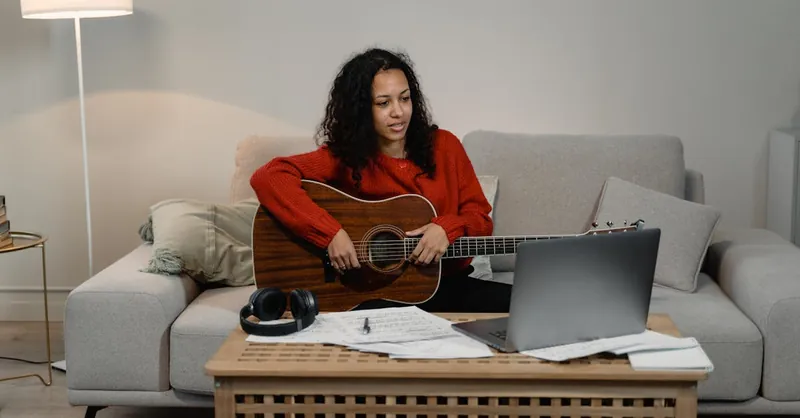
Image courtesy of Tima Miroshnichenko
Sample Weekly Practice Plan: Tailored Schedules for Different Time Commitments and Skill Levels
Creating a structured weekly practice plan helps you stay organized while covering essential music theory topics and their application to guitar and piano. To suit varying schedules and abilities, here are sample plans that balance theory study, instrument practice, and ear training, ensuring steady progress whether you have limited or ample practice time.
Beginner Practice Plan (15-30 Minutes Daily)
Perfect for new learners with limited time, this plan emphasizes fundamental theory concepts alongside practical playing to build a strong foundation.
- Monday – Notation and Rhythm
- 10 minutes: Learn note values, time signatures, and simple rhythms
-
10 minutes: Clap and play basic rhythms on guitar or piano
-
Tuesday – Intervals and Scales
- 10 minutes: Study intervals and the major scale structure
-
10 minutes: Practice major scale patterns on your instrument
-
Wednesday – Basic Chords
- 10 minutes: Understand triad construction
-
10-15 minutes: Play major and minor chords on guitar/piano, focusing on finger positioning
-
Thursday – Key Signatures & Circle of Fifths
- 10 minutes: Learn key signatures theory
-
10 minutes: Visualize and memorize the circle of fifths
-
Friday – Progressions and Ear Training
- 10 minutes: Play simple I-IV-V chord progressions
-
10 minutes: Ear training exercises on interval identification
-
Weekend – Review and Creative Application
- 15-20 minutes: Review the week's topics, improvise simple melodies or chord progressions applying what you've learned
Intermediate Practice Plan (45-60 Minutes Daily)
Designed for learners who want to deepen music theory knowledge and its practical use, this plan includes more advanced topics and extended playing sessions.
- Monday – Advanced Scales and Modes
- 15 minutes: Explore modal scales like Dorian, Mixolydian
-
15 minutes: Practice modal scale patterns and improvisation on guitar/piano
-
Tuesday – Extended Chords and Voicings
- 20 minutes: Study seventh and extended chord construction
-
20 minutes: Practice chord inversions, voicings, and transitions
-
Wednesday – Rhythm and Meter Complexities
- 15 minutes: Work on syncopation, dotted notes, and compound meters
-
15 minutes: Apply rhythms in playing exercises or accompaniment
-
Thursday – Ear Training and Sight Reading
- 20 minutes: Interval and chord quality identification by ear
-
20 minutes: Sight-read simple sheet music or tablature
-
Friday – Harmony and Progression Analysis
- 20 minutes: Analyze common chord progressions (ii-V-I, I-vi-ii-V)
-
20 minutes: Play and compose progressions on your instrument
-
Weekend – Creative Integration and Review
- 30-40 minutes: Compose, arrange, or improvise using studied theory concepts; review difficult topics
Tips to Customize Your Weekly Plan
- Adjust the focus areas based on your personal goals, whether it’s mastering jazz chords on guitar or improving piano sight-reading.
- Incorporate short daily ear training sessions, even 5 minutes, to enhance musical intuition progressively.
- Use weekends for review and creative exploration to solidify theory and keep practice enjoyable.
- Track your progress weekly and adapt your schedule to challenge yourself or reinforce weaker areas.
By following these example practice plans tailored for different time availabilities and skill levels, you develop a balanced, effective music theory routine that integrates seamlessly with your guitar and piano playing. This consistent, goal-oriented approach propels you confidently toward mastering theory fundamentals while making your musical journey engaging and sustainable.
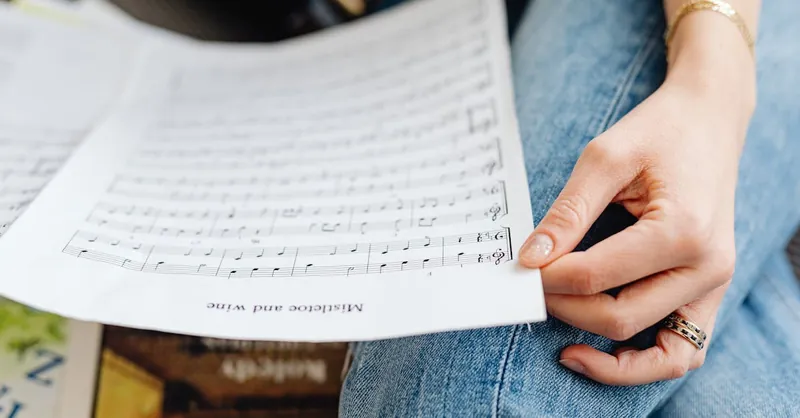
Image courtesy of Photo By: Kaboompics.com
Common Challenges and How to Overcome Them: Addressing Boredom, Confusion, and Lack of Immediate Progress
When building a music theory practice schedule for guitar and piano, beginners often face common hurdles that can disrupt motivation and slow progress. The biggest challenges include boredom, confusion over complex concepts, and the frustration of not seeing immediate results. Recognizing these obstacles early and applying targeted strategies to overcome them ensures a more enjoyable and effective learning journey.
Overcoming Boredom
Music theory can sometimes feel repetitive or abstract, especially when practicing topics like scales or interval identification. To keep boredom at bay:
- Vary your practice activities by mixing hands-on playing, ear training, and creative improvisation instead of focusing solely on theory drills.
- Use interactive apps and games that make learning theory engaging through quizzes and challenges specifically designed for guitar and piano players.
- Set small, achievable goals for each session to maintain a sense of accomplishment and momentum.
Tackling Confusion in Theory Concepts
Complex ideas like chord extensions, modal harmony, or rhythm subdivisions can be intimidating, causing learners to feel stuck or overwhelmed. To combat confusion:
- Break down difficult topics into simpler parts, studying one element at a time before linking them together.
- Relate abstract theory to concrete examples on your instrument, such as visualizing chord shapes on the guitar fretboard or playing scale modes on the piano keyboard.
- Seek multiple explanations through different resources like videos, books, or one-on-one lessons, as varied perspectives often clarify challenging material.
Managing the Lack of Immediate Progress
Music theory mastery takes time, and it’s normal not to see instant results, which can lead to discouragement. To stay motivated despite slow progress:
- Keep a practice journal to track small improvements over days and weeks, highlighting even subtle gains in understanding or playing ability.
- Incorporate regular review sessions where you revisit previous topics to solidify retention and notice growth.
- Embrace patience by recognizing that consistent, focused practice compounds over time, leading to breakthroughs that suddenly make complex theory “click” in your mind.
By proactively addressing these common challenges—boredom, confusion, and delayed progress—you create a resilient mindset and practice routine. This approach not only fosters long-term success in mastering music theory for guitar and piano but also makes the learning process more enjoyable and sustainable.
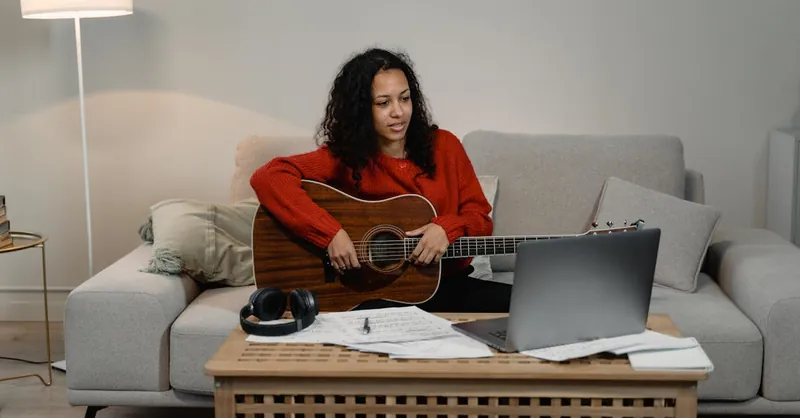
Image courtesy of Tima Miroshnichenko
